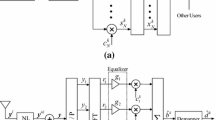Abstract
In this paper, we consider the receiver design problem for the uplink multiuser code division multiple access (CDMA) communication system based on the neural network technique. The uplink multiuser CDMA communication system model is described in the form of space–time domain through antenna array and multipath fading expression. Novel suitable neural network technique is proposed as an effective signal processing method for the receiver of such an uplink multiuser CDMA system. By the appropriate choice of the channel state information for the neural network parameters, the neural network can collectively resolve the effects of both the inter-symbol interference due to the multipath fading channel and the multiple access interference in the receiver of the uplink multiuser CDMA communication system. The dynamics of the proposed neural network receiver for the uplink multiuser CDMA communication system is also studied.
Similar content being viewed by others
References
Dimitriou N., Tafazolli R., Sfikas G. (2000) Quality of service for multimedia CDMA. IEEE Communications Magazine, 38(7): 88–94
Wang X., Poor H.V. (2004) Wireless communication systems: advanced techniques for signal reception. Prentice Hall, Upper Saddle River, NJ
Kim Y., Jeong B., Chung J., Hwang C., Ryu J. (2003) Beyond 3G: vision, requirements, and enabling technologies. IEEE Communications Magazine, 41(3): 120–124
Fantacci R., Chiti F., Marabissi D., Mennuti G., Morosi S., Tarchi D. (2005) Perspectives for present and future CDMA-based communications systems. IEEE Communications Magazine, 43(2): 95–100
Verdu S. (1998) Multiuser detection. Cambridge University Press, Cambridge, UK
Paulraj A.J., Williams C.B. (1997) Space–time processing for wireless communications. IEEE Signal Processing Magazine, 14(6): 49–83
Hopfield J.J. (1982) Neural networks and physical systems with emerging collective computational abilities. Proceedings of the National Academy of Sciences of the United States of America, 79: 2554–2558
Hopfield J.J., Tank D.W. (1985) Neural computation of decisions in optimization problems. Biological Cybernetics, 52: 141–152
Shayesteh, M. G., & Amindavar, H. (2002). Multiuser detection in DS/CDMA systems using neural networks. In IEEE 7th International Symposium on Spread-Spectrum Techniques and Applications, pp. 506–510.
Miyajima T., Hasegawa T. (1996). Multiuser detection using a Hopfield network for asynchronous code-division multiple-access systems. IEICE Transactions on Fundamentals of Electronics, Communications and Computer Science, E79-A(12): 1963–1971
Kechriotis G.I., Manolakos E.S. (1996) Hopfield neural network implementation of the optimal CDMA multiuser detector. IEEE Transactions on Neural Networks, 7(1): 131–141
Waheed K., Salem F.M. (2005) Blind information theoretic multiuser detection algorithms for DS-CDMA and WCDMA downlink systems. IEEE Transactions on Neural Networks, 16(4): 937–948
Chen, S., & Hanzo, L. (2002). Block-adaptive kernel-based CDMA multiuser detection. In Proceedings of IEEE international conference on communications, pp. 682–686.
Ertin E., Mitra U., Siwamogsatham S. (2001) Maximum-likelihood-based multipath channel estimation for code-division multiple-access systems. IEEE Transactions on Communications, 49(2): 290–302
Poor H.V., Wang X. (1997) Code-aided interference suppression for DS/CDMA communications-Part I: Interference suppression capability. IEEE Transactions on Communications, 45(9): 1101–1111
D’Amico A.A., Mengali U., Morelli M. (2003) Channel estimation for the uplink of a DS-CDMA system. IEEE Transactions on Wireless Communications, 2(6): 1132–1137
Hachem, W., Desbouvries, F., & Loubaton, P. (2000). Blind channel estimation for CDMA systems: An induced cyclostationarity approach. In Proceedings of ICASSP’2000, 5, pp. 2477–2480.
Sun L., Bi G., Zhang L. (2007) Orthonormal subspace tracking algorithm for space–time multiuser detection in multipath CDMA channels. IEEE Transactions on Vehicular Technology, 56(6): 3838–3845
Smith K., Palaniswami M., Krishnamoorthy M. (1998) Neural techniques for combinatorial optimization with applications. IEEE Transactions on Neural Networks, 9(6): 1301–1318
Zhu W., Liang T.Y., Shieh C.K. (1999) A Hopfield neural network based task mapping method. Computer Communications, 22: 1068–1079
Engelhart A., Teich W.G., Lindner J., Jeney G., Imre S., Pap L. (2002) A survey of multiuser/multisubchannel detection schemes based on recurrent neural networks. Wireless Communications and Mobile Computing, 2: 269–284
Salcedo Sanz S., Santiago Mozos R., Bousoño Calzón C. (2004) A hybrid Hopfield network- simulated annealing approach for frequency assignment in satellite communications systems. IEEE Transactions on Systems, Man, and Cybernetics B, 34: 1108–1116
Haykin S. (1999) Neural networks: A comprehensive foundation (2nd ed). Prentice Hall, Upper Saddle River, NJ
Haykin S. (1996) Adaptive filter theory (3rd ed). Prentice-Hall, Englewood Cliffs, NJ
Author information
Authors and Affiliations
Corresponding author
Rights and permissions
About this article
Cite this article
Zheng, ZW. Receiver Design for Uplink Multiuser Code Division Multiple Access Communication System Based on Neural Network. Wireless Pers Commun 53, 67–79 (2010). https://doi.org/10.1007/s11277-009-9671-x
Received:
Accepted:
Published:
Issue Date:
DOI: https://doi.org/10.1007/s11277-009-9671-x




